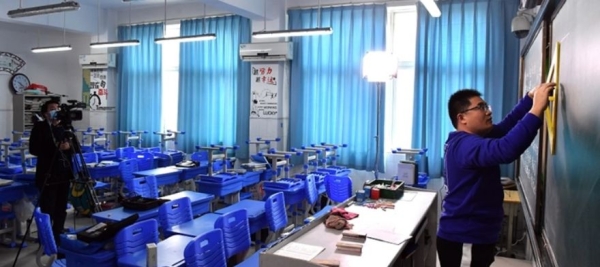On February 9, nearly 200 million primary and secondary school students in China started their new semester – online.
With all schools closed down due to the coronavirus outbreak, the country has embarked on what might amount to the largest simultaneous online learning exercise in human history.
In advance of the 2020 edition of Mobile Learning Week dedicated to the theme of artificial intelligence and inclusion, UNESCO has been in contact with the Ministry of Education of the People’s Republic of China to offer support and understand how technology is being leveraged to ensure that the school year continues.
After suspending the opening of schools for the new semester, the Ministry launched an initiative entitled “Ensuring learning undisrupted when classes are disrupted.” Over the course of two weeks, with all face-to-face meetings banned, the Ministry organized tele-conferences with school management agencies, online platform and course providers, telecom providers and other stakeholders to plan the implementation of the initiative.
Ensuring that all students can access digital learning opportunities is the foremost challenge, together with teachers’ readiness to design and deliver online tutorials. This led the Education Ministry to join forces with the Ministry of Industry and Information Technology in order to:
-
Mobilize all major telecom service providers to boost internet connectivity service for online education, especially for the under-served regions.
-
Upgrade the bandwidth of major online education service platforms, especially the capacity of the National Cloud-Platform for Educational Resources and Public Service in serving millions of visitors simultaneously.
-
Mobilize society-wide resources for the provision of online courses and resources. More than 24,000 online courses have been made accessible for university students. 22 validated online course platforms, most them empowered by Artificial Intelligence, have been mobilized to provide primary and secondary schools with free online courses.
-
Adopt flexible and appropriate methodologies to facilitate learning. Schools and teachers are advised to choose appropriate modes of delivery based on local e-readiness, including online platforms, digitalized TVs or mobile Apps. Teachers have received guidance on teaching methodologies including through live-streaming of online tutorials and MOOCs. The recommended number of online learning hours varies by grade.
-
Strengthen online security through collaboration with the telecom sector and online platform service providers.
-
Provision of psycho-social support and courses to impart knowledge about the virus and protection against it.
“In May 2019, China hosted the UNESCO International Conference on Artificial Intelligence and Education, the first of its kind. One of its main messages was about ensuring that technology serves inclusion and equity in education, and does not widen the digital divide,” said Stefania Giannini, Assistant Director-General for Education.
”China’s response to a nationwide health emergency has been guided by this concern, so that learning continues for all children and youth. We are working with partners in China to provide technical advice with the main concern that priority is given to the most vulnerable groups to ensure that they are not left behind.”
“The response of China’s education system to the COVID-19 emergency is remarkable, in terms of depth of the remote learning facilities being made available, and of the scale required to cover needs. Just one of the platforms, offered by the Ministry of Education, allows for 50 million students and teachers to connect simultaneously, enabling them to access primary and secondary education modules, as well as life skills content relevant to a health emergency,” said Marielza Oliveira, Director of the UNESCO Beijing office. “It is impressive how fast China created partnerships between national and local governments, private sector and civil society, so that these capabilities could be augmented by additional learning resources, through, for example, TV broadcasting and social media livestreaming. Of course, more would be ideal: support to parents on effective supervision of their children’s learning activities, multilingual content for ethnic minorities, better accessibility for persons with disabilities, improved ICT connectivity and teacher skills in rural areas, better safety and privacy protections for children while online... I’m sure that, with the right efforts to improve remote learning, the extraordinary resources being deployed will remain as a positive legacy to Chinese society long after the epidemic ends.”
A monitoring and evaluation mechanism is being set up to evaluate students’ learning outcomes. When physical school campuses re-open, education programmes will be adjusted according to the evaluation results.
(Source: UNESCO Beijing Office)
面对新冠病毒,中国如何确保“停课不停学”
2月9日,近2亿中国小学生和中学生在网上开启了他们的新学期。
由于所有学校均因新冠病毒疫情而关闭,中国启动了人类历史上最大规模的线上同步学习活动。
在以人工智能和包容性为主题的2020年移动学习周即将来临之际,教科文组织一直与中国教育部保持联系以提供必要支持,并了解中国如何利用科技保障本学年得以继续。
在决定推迟新学期开学后,中国教育部发起了一项名为“停课不停学”的倡议。在两周时间内,由于所有线下会议都被禁止,教育部与学校管理机构、在线平台和课程提供机构、电信运营商和其他利益相关方举行了远程会议,以规划该倡议的实施方式。
如何确保所有学生都能获得数字学习机会是最严峻的挑战,同时还需要确保教师们为设计和教授在线课程做好了准备。这促使教育部与工业和信息化技术部合作,以便:
-
动员所有主要电信服务运营商加强在线教育的互联网接入服务,尤其要提高互联网接入落后地区的服务水平。
-
提升主要线上教育服务平台的带宽,尤其要确保国家教育资源公共服务平台有能力同时服务数百万访问者。
-
动员全社会的力量以提供线上课程和教学资源。目前已经有24000多门线上课程向大学生开放,另有22个经过验证的线上课程平台已经被动员为中小学提供免费的在线课程,其中大多数平台由人工智能驱动。
-
采取灵活和适当的方法促进学习。教育部建议学校和教师根据当地的信息化水平选择合适的授课方式,包括网络平台、数字电视或移动应用程序等。教师们已经收到了关于教学方法的指导,包括线上直播授课和网课(MOOCs)等。教育部还建议不同年级采取不同的线上学习时长。
-
通过与电信部门和网络平台服务提供商合作,加强网络安全。
-
提供社会心理援助和相关课程以传授有关病毒及如何预防的知识。
教育助理总干事吉亚妮(Stefania Giannini)说:“2019年5月,中国主办了首届教科文组织国际人工智能与教育大会。大会传递的主要理念之一就是确保科技服务于教育包容性和公平性,以及不会扩大数字鸿沟。”
“中国在应对这场全国性突发卫生事件时始终以这种关切为指导,从而使所有儿童和青少年都能继续学习。我们正在与中国的伙伴合作以提供技术建议,我们的主要关切是让最弱势群体得到最优先考虑,以确保他们不会被忽视。”
“无论从正在开放的远程教育设施的深度来看,还是从满足学习需要所需的规模来看,中国教育系统对新冠肺炎这一紧急情况的应对都是非同凡响的。仅仅是其中一个由中国教育部提供的平台就能容纳5000万名学生和教师同时联络,使他们能够访问中小学教学模块以及与卫生紧急情况相关的生活技能内容,”教科文组织驻华代表欧敏行(Marielza Oliveira)说,“中国在国家和地方政府、私营部门和公民社会之间建立伙伴关系的速度令人惊叹,这些伙伴关系为学习资源提供了更多传播途径,例如通过电视广播和社交媒体直播等。当然,达到理想状况还需要更多努力:支持家长有效监督子女的学习活动、为少数民族提供多语言内容、为残疾人提供更好的无障碍平台、增强农村地区的信息和通信技术接入和教师技能、更好地保障儿童上网时的安全和隐私……我相信,只要为优化远程学习做出适当的努力,在疫情结束后很长一段时间内,这正在被动用的巨大资源仍将是中国社会的宝贵财富。”
目前有关部门正在建立一个监测和评价机制,以评估学生的学习成果。当学校校园重新开放时,教学方案将根据评估结果得到调整。


